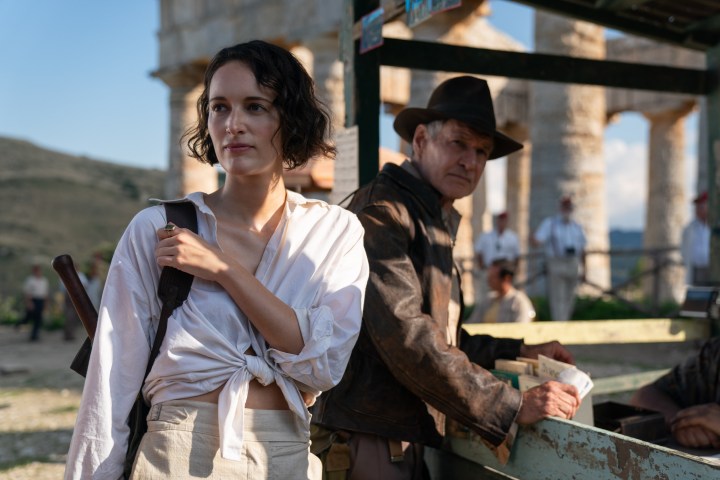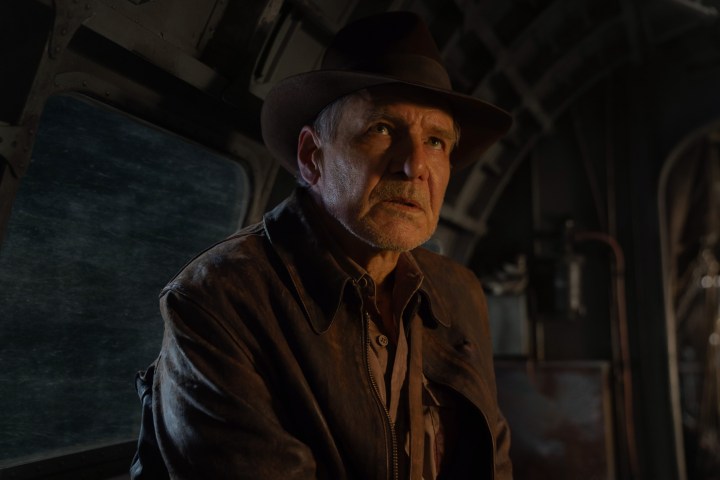
“Indiana Jones and the Dial of Destiny lacks many of the qualities that made the franchise great in the first place, but its potent emotional highs help make up for some of its biggest flaws.”
- Harrison Ford’s nuanced, emotionally introspective lead performance
- Phoebe Waller-Bridge and Mads Mikkelsen’s scene-stealing supporting turns
- A shockingly sweet, genuinely moving ending
- James Mangold’s surprisingly stuffy direction
- Several boring, cookie-cutter action set pieces
- An overly convoluted and long script
One of the oddest mixed bags of the year, Indiana Jones and the Dial of Destiny is both as bad as many expected and better than most likely imagined. The film is not only the first Indiana Jones installment not to be directed by Steven Spielberg, but it’s also meant to serve as the series’ fifth and final chapter. Both those aspects of The Dial of Destiny set its director, Ford v Ferrari and Logan helmer James Mangold, up to succeed and fail in ways that are well-suited to him. On the one hand, The Dial of Destiny lacks many of its franchise’s defining traits — namely, its uniquely Spielbergian verve.
On the other hand, the film boasts a surprisingly layered thematic depth that could only have been achieved by a filmmaker like Mangold, whose affection for his characters has made him a go-to director for franchise swan songs like Dial of Destiny and Logan. As disappointing as they are, his latest film’s numerous technical failings feel difficult to pin directly on him, too. Mangold isn’t, after all, the only relatively accomplished studio filmmaker working today who makes movies that still rely far too much on shoddy CGI and digital effects.
The biggest problem with The Dial of Destiny is that it doesn’t ever feel like Mangold had that much fun making the film. Throughout its 154-minute runtime, one can feel Mangold understandably buckling under the weight of his unparalleled predecessor’s legacy. The Dial of Destiny consequently lacks the directorial mischievousness that, regardless of their flaws, is present in all four of the previous Indiana Jones movies. At the same time, the overly considerate touch Mangold brings to The Dial of Destiny is also what ensures that its melancholic, surprisingly sweet final notes land as well as they do.

Indiana Jones and the Dial of Destiny opens in fitting fashion with a trip back in time to 1944 Europe. The blockbuster’s prologue follows Harrison Ford’s Indiana Jones as he and his bumbling archeological partner in crime, Basil Shaw (Toby Jones), get caught trying to save a precious historical artifact from a legion of Nazi soldiers. Their capture leads to a series of mishaps and confrontations on a Nazi train that result in Indy and Basil coming into possession of one-half of the famed Archimedes Dial, an artifact coveted by Dial of Destiny’s resident villain and Wernher von Braun stand-in, Jürgen Voller (Mads Mikkelsen).
Twenty-five years later, Ford’s older Indy lives alone in a New York City apartment, slowly inching closer to full-blown retirement. Still grieving the loss of his son and on the verge of divorcing his wife, Marion Ravenwood (Karen Allen), Indy is quickly pulled out of his listless existence by the arrival of his goddaughter, Helena Shaw (Phoebe Waller-Bridge), the surviving daughter of Jones’ Basil. After he’s conned into giving her his half of the Archimedes Dial, Indy sets out to retrieve the artifact before either Helena sells it or Mikkelsen’s still-scheming Voller gets his hands on it. What follows is a globetrotting cat-and-mouse game that sticks fairly close to the franchise’s established adventure serial formula.
Where The Dial of Destiny strays from its franchise’s well-established path is in its reliance on visual effects that make huge portions of its world and action sequences look rubbery and fake. The film’s Nazi Germany-set prologue is the only sequence that feels truly lighthearted and carefree, as if Mangold gave himself permission during those days on set to actually take a few pages out of Spielberg’s playbook and just have fun. Unfortunately, the sequence suffers greatly from its reliance on de-aging VFX that is meant to make Ford look like he did in the 1980s but just make him resemble a video game character more than a living, breathing human being.

Once Mangold ditches the film’s digitally altered Indy, Ford proves to be as good as ever in The Dial of Destiny. As he’s gotten older, Ford has swapped out his once-signature gruffness and physically imposing presence for a more emotionally introspective persona, but not since Blade Runner 2049 has he felt as in touch with all of his capabilities as he does here. His comedic timing is as perfect as it’s ever been, and his commitment to playing his iconic archeologist this time around as a heartbroken, despondent man — someone whose grief and passion for history has left him stranded in the present — is one of the only things about The Dial of Destiny that truly justifies its existence.
Opposite him, both Waller-Bridge and Mikkelsen prove to be well-cast counters to Ford’s Indiana, though, the former’s Helena does suffer a bit from the film’s unnecessarily prickly initial rendering of her. Together, the three bring real life to The Dial of Destiny’s three central forces, even as Mangold and cinematographer Phedon Papamichael frequently fail to match Spielberg’s signature directorial eye. Most of Dial of Destiny’s action sequences fall flat, either due to their own imperfect VFX or Mangold’s overly neat style. The film remains so concerned at all times with moving its plot forward that it routinely chooses not to luxuriate in the chaos or violence of its various set pieces.
The inspired, silent movie visual gags that Spielberg brought to his Indiana Jones movies are nowhere to be found in The Dial of Destiny. No sequence in the film matches the screwball absurdity of Ford and Kate Capshaw’s desperate nightclub scramble in Temple of Doom, the former’s prolonged fistfight around a moving airplane in Raiders of the Lost Ark, or the balletic, oversized grandiosity of that film’s opening temple exploration and escape. Instead, many of The Dial of Destiny’s action sequences feel strangely allergic to fun.

Mangold’s strait-laced visual approach robs Dial of Destiny of the gory nastiness that Spielberg and George Lucas often went out of their way to inject into the franchise. The film features more than a few punches to Nazi faces, but it never melts its villains’ mugs off in front of our eyes, rips out their hearts, pincushions any of them to walls with arrows, or lets any of them be eaten alive by fire ants. The result of all these omissions is an Indiana Jones film that, at times, lacks any real personality, which isn’t something that can be said of even the franchise’s worst Spielberg-directed installments like Indiana Jones and the Kingdom of the Crystal Skull.
While Mangold never comes close to replicating the amped-up energy of Spielberg’s filmmaking or the schlocky gore that he and Lucas embraced in the series’ initial entries, the Ford v Ferrari director does bring a delicate touch to The Dial of Destiny’s story and themes. In its third act, the film commits so wholeheartedly to the biggest sci-fi twist in its franchise’s history that it briefly achieves a transcendent kind of goofiness. Mangold, with the help of Ford’s emotionally raw central performance, uses that tonal high to propel The Dial of Destiny toward an ending that is subversively quiet and moving.
For much of the film, Mangold wisely resists replaying any of the Indiana Jones franchise’s old hits. He strives to put his own stamp on a series that will forever belong to its original director and star. Even if he doesn’t totally succeed, the filmmaker’s resistance to tugging on his viewers’ nostalgic memories is what makes The Dial of Destiny’s final scene, which pays direct tribute to the past, so effective. Ironically, it’s when The Dial of Destiny decides to retrace its franchise’s footsteps that it manages to carve out a new path for both itself and its hero.
Indiana Jones and the Dial of Destiny is now playing in theaters.
Editors’ Recommendations
Services Marketplace – Listings, Bookings & Reviews
